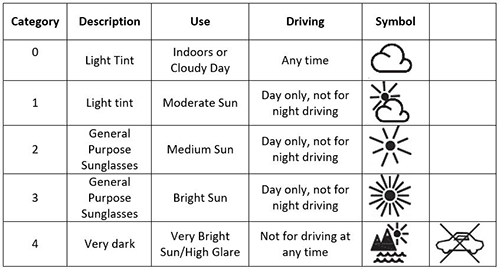Sunglasses: A shady business
The sky’s blue, sun is shining and the snow, fog and rain are a distant memory. It’s time to get the top down, the shades on and celebrate the great British summer with some open-air motoring. But hold on a minute - those shades might make you look cooler than an ice box, but are they OK for driving? Are sunglasses a boon or burden for the safe driver?
Tim Shallcross, IAM RoadSmart’s head of technical policy and advice, has put together a set of tips for Sunglasses Day (today – 27 June) outlining key information that you should be aware of.
Did you know about the EU standards for sunglasses?
As a matter of fact, there is an EU standard for sunglasses, ensuring the frames are reasonably strong and sweat resistant and the lenses are shatterproof, scratch resistant and give good protection against harmful ultra-violet light.
Any which show the CE mark (and any sold in the EU should have it) should come up to the standards, but they are also graded into five categories - 0 to 4 - to show how dark the tint is, or more specifically, how much visible light they let through.
What categories of sunglasses are there?
Category 0 specs allow 80% to 100% of visible light through and are fine for driving at any time. Categories 1, 2 and 3 are progressively darker tints, shielding against brighter levels of sunshine, and while they are all fine for daylight driving, none of them should be worn if you’re driving at night. The darkest is category 4, which lets just 3% to 8% of the light through. These are very dark, like ski goggles. They are so dark that they should not be used for driving at any time, and category 4 sunglasses must be labelled as unsuitable for driving.

Where can I find this information?
Seems simple enough. Sunglasses on sale in shops such as chemists or opticians do have the label and are marked with the category - normally on the arm. However, online shoppers beware; a look through several shopping websites revealed that very few sellers display the tint category or any symbol, so you have no way of telling whether the glasses are suitable for driving until they arrive. A few are advertised as category 4 and suggested as being good for cyclists, although the official standard states they are “not suitable for driving and road use”, and common sense would say that if they’re too dark for driving, they’re too dark for cycling.
Photochromic glasses aren’t marked but they should be fine for most cars because they respond to ultraviolet light to darken. Car windows block UV light, so the glasses will stay more or less clear. Watch out if you drive a convertible though, because once the roof’s down the glasses will darken, but at their darkest they still allow about 20% of light through, putting them around category 2 or 3. Just be aware that they will stay dark for quite a while if you drive into a tunnel or underpass or a long stretch of shadows.
So, while the sun stays shining, check the tint number before you drive and make sure your shades keep you safe as well as cool.
ENDS
Notes to editors:
1. Richard Gladman is IAM RoadSmart’s head of driving and riding standards.
2. IAM RoadSmart has a mission to make better drivers and riders in order to improve road safety, inspire confidence and make driving and riding enjoyable. It does this through a range of courses for all road users, from online assessments through to the advanced driving and riding tests. IAM RoadSmart is the trading name of all businesses operated by the UK’s largest road safety charity, the Institute of Advanced Motorists (IAM) and was formed in April 2016 combining the IAM, IAM Drive & Survive, PDS and IAM Driver Retraining Academy. The organisation has 92,000 members and campaigns on road safety on their behalf. At any one time there are over 7,000 drivers and riders actively engaged with IAM RoadSmart’s courses, from members of the public to company drivers, while our Driver Retraining Academy has helped 2,500 drivers to shorten their bans through education and support programmes.
To find out more about IAM RoadSmart products and services visit the new website www.iamroadsmart.com
To find out the name of your own local IAM RoadSmart group please visit: https://www.iamroadsmart.com/local-groups
Media contacts:
Further information from:
IAM RoadSmart press office – 020 8996 9777
press.office@iam.org.uk / www.iamroadsmart.com
ISDN broadcast lines available
Follow us:
On Facebook: www.facebook.com/IAMRoadSmart
On Twitter: @IAMRoadSmart
ENDS ALL

